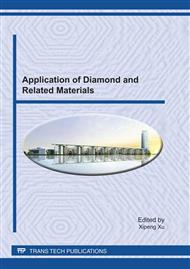p.22
p.27
p.33
p.38
p.42
p.47
p.52
p.58
p.67
A Comparative Study: Tool Life and Wear of Thin-Walled Monolayer Brazed Diamond Core Drill Fabricated with Ni-Cr and Ag-Cu-Ti Alloy
Abstract:
Monolayer brazed diamond tools, which are high bonding strength at the interface between brazing alloy and grits, are becoming the active field in which improvements in processing and advanced products can be anticipated. Some researchers proposed brazing diamond methods with Ni-Cr and Ag-Cu-Ti alloy, but there is a shortage of the comparative study of the characteristics of the brazed diamond tools fabricated with the different brazing alloy. In this paper, machining performance experiments have been carried out, including contrast tests about tool life and machining efficiency for thin-walled monolayer brazed diamond core drills fabricated with Ni-Cr and Ag-Cu-Ti alloy. The results show that the Ag-Cu-Ti alloy can improve the machining performance. Wear mechanism of diamond grits was studied in those drilling processes. The results show that the low ratio of grit breakdown of the core drill using Ag-Cu-Ti alloy is the key factor of its longer life. Furthermore, based on the experimental results, the areas of the grits wear flat increase the feed force, and decrease the machining efficiency.
Info:
Periodical:
Pages:
42-46
Citation:
Online since:
June 2011
Authors:
Keywords:
Price:
Сopyright:
© 2011 Trans Tech Publications Ltd. All Rights Reserved
Share:
Citation:


